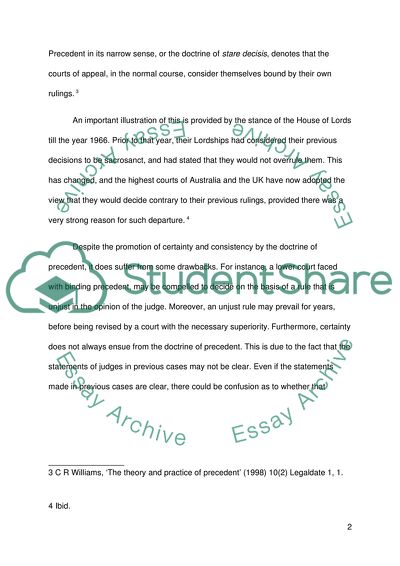Cite this document
(Doctrine of Precedent Report Example | Topics and Well Written Essays - 2000 words, n.d.)
Doctrine of Precedent Report Example | Topics and Well Written Essays - 2000 words. https://studentshare.org/law/1791883-in-the-appellate-court-of-last-resort-a-balance-must-be-struck-between-the-need-on-one-side-for-the-legal-certainty-resulting-from-the-binding-effect-of-previous-decisions-and-on-the-other-side-the-avoidance-of-undue-restrictions-on-the-proper-developm
Doctrine of Precedent Report Example | Topics and Well Written Essays - 2000 words. https://studentshare.org/law/1791883-in-the-appellate-court-of-last-resort-a-balance-must-be-struck-between-the-need-on-one-side-for-the-legal-certainty-resulting-from-the-binding-effect-of-previous-decisions-and-on-the-other-side-the-avoidance-of-undue-restrictions-on-the-proper-developm
(Doctrine of Precedent Report Example | Topics and Well Written Essays - 2000 Words)
Doctrine of Precedent Report Example | Topics and Well Written Essays - 2000 Words. https://studentshare.org/law/1791883-in-the-appellate-court-of-last-resort-a-balance-must-be-struck-between-the-need-on-one-side-for-the-legal-certainty-resulting-from-the-binding-effect-of-previous-decisions-and-on-the-other-side-the-avoidance-of-undue-restrictions-on-the-proper-developm.
Doctrine of Precedent Report Example | Topics and Well Written Essays - 2000 Words. https://studentshare.org/law/1791883-in-the-appellate-court-of-last-resort-a-balance-must-be-struck-between-the-need-on-one-side-for-the-legal-certainty-resulting-from-the-binding-effect-of-previous-decisions-and-on-the-other-side-the-avoidance-of-undue-restrictions-on-the-proper-developm.
“Doctrine of Precedent Report Example | Topics and Well Written Essays - 2000 Words”. https://studentshare.org/law/1791883-in-the-appellate-court-of-last-resort-a-balance-must-be-struck-between-the-need-on-one-side-for-the-legal-certainty-resulting-from-the-binding-effect-of-previous-decisions-and-on-the-other-side-the-avoidance-of-undue-restrictions-on-the-proper-developm.


